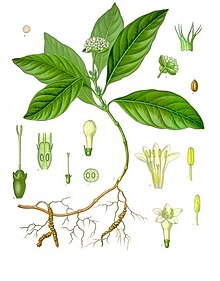Carapichea ipecacuanha
| Carapichea ipecacuanha | |
|---|---|

| |
| Scientific classification | |
| Kingdom: | Plantae |
| Clade: | Tracheophytes |
| Clade: | Angiosperms |
| Clade: | Eudicots |
| Clade: | Asterids |
| Order: | Gentianales |
| Family: | Rubiaceae |
| Genus: | Carapichea |
| Species: | C. ipecacuanha
|
| Binomial name | |
| Carapichea ipecacuanha (Brot.) L.Andersson
| |
| Synonyms | |
|
Callicocca ipecacuanha | |

Carapichea ipecacuanha is a
Description
Ipecacuanha is a slow-growing plant, which reduces its commercial appeal as a crop plant.[citation needed] It is seldom cultivated in South America but it has been cultivated in India and elsewhere.[2]
The root of ipecacuanha has been used in preparation of the medicament, the syrup, is simple or divided into a few branches, flexuous, and composed of rings of various size.[citation needed] It is somewhat fleshy when fresh, and appearing as if closely strung on a central woody cord.[citation needed] The different kinds known in commerce (gray, red, brown) are all produced by the same plant, the differences arising from the age of the plant, the mode of drying, etc.[citation needed] Various other plants can be used as substitutes for it.[clarification needed][citation needed]
History
Ipecacuanha was known to Europe by the mid 17th century.
Ipecacuanha has a long history of use as an
In the 19th century, women prisoners at the Cascades Female Factory, Tasmania, were routinely given "a grain or so of ipecacuanha" as a precaution, especially "upon ladies with gross health and fiery temperaments."[5]
Chemical constituents
Ipecacuanha contains the alkaloids
References
- ISBN 9785040211166.
- ^ ISBN 9780415924528.
- PMID 14595067.
- ^ Daniels, Kay. Convict Women. Allen & Unwin, 1998, p. 129.
- ISBN 0306454653.
- ^ "530. Ipecacuanha.—Ipecac. | Henriette's Herbal Homepage".
External links
- R05CA04 (WHO) therapeutic classification
- . Encyclopædia Britannica (11th ed.). 1911.
- . New International Encyclopedia. 1905.
